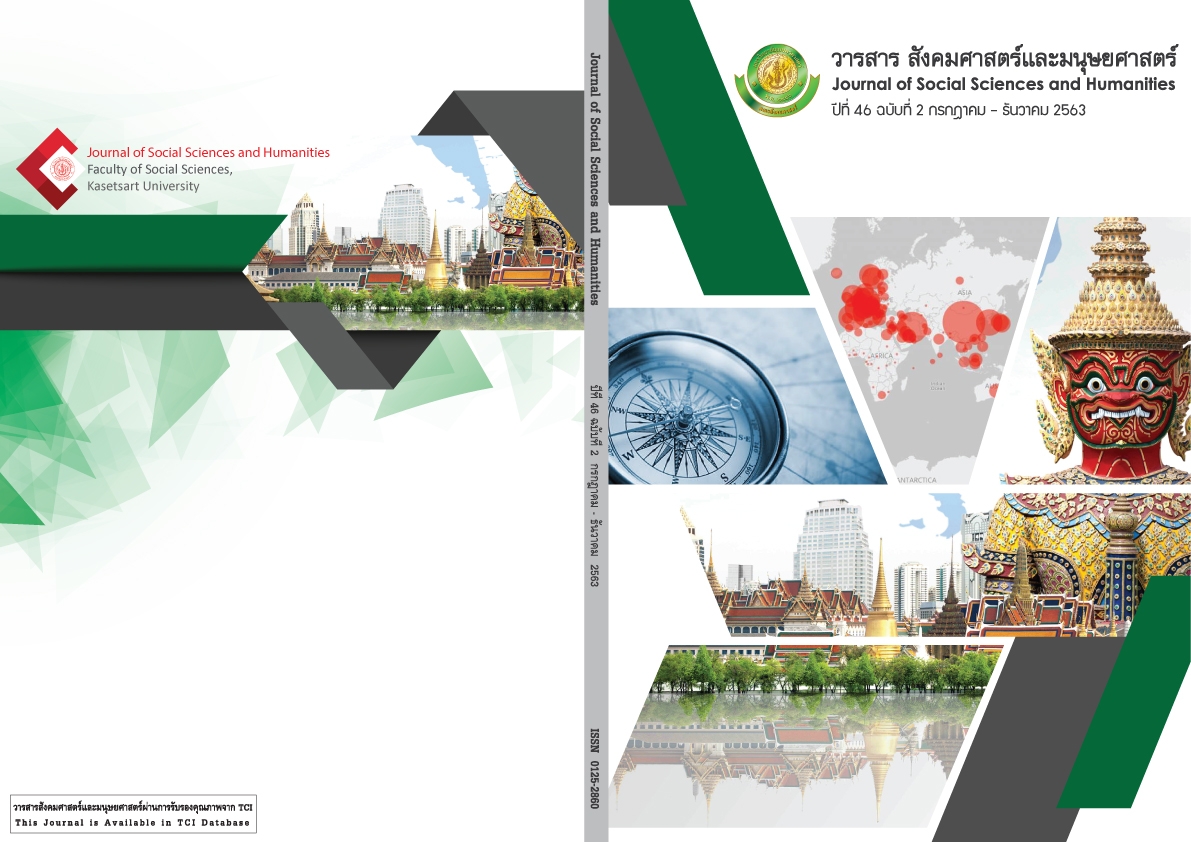การจัดการทางวัฒนธรรมชนเผ่าพื้นเมือง (นิกริโต) ประเทศมาเลเซีย
Main Article Content
บทคัดย่อ
บทความวิจัยนี้ศึกษาชนพื้นเมือง“โอรังอัสลี” กลุ่มนิกริโต (ยะไฮ) ที่มีการกระจายตัวอยู่ในตอนบนของคาบสมุทรมลายู ประเทศมาเลเซีย มีวัตถุประสงค์เพื่อศึกษาการดำเนินนโยบาย และผลกระทบจากการดำเนินนโยบายการจัดการทางวัฒนธรรมชนเผ่าพื้นเมืองของประเทศมาเลเซีย โดยศึกษาวิจัยข้อมูลเชิงเอกสารและชนเผ่าพื้นเมืองโอรังอัสลี กลุ่มนิกริโต ภาษายะไฮ ณ หมู่บ้านสุไหงราอูล (KG. Orangasli Sungai Rual) ในเมืองเจลี่ (Jeli) ในเขตรัฐกลันตัน ประเทศมาเลเซีย จากการศึกษาจึงพบว่าคนกลุ่มนี้ได้รับการยอมรับเป็น “พลเมืองมาเลเซีย” และได้รับความสนใจมาตั้งแต่ยุคอาณานิคมอังกฤษ เป็นระยะเวลายาวนาน สามารถแบ่งช่วงของผลกระทบที่เกิดกับกลุ่มโอรังอัสลีเหล่านี้ ได้เป็น 4 ช่วง ดังนี้ ช่วงอาณานิคม ช่วงประกาศสภาวะฉุกเฉิน ปราบปรามขบวนการก่อการร้ายคอมมิวนิสต์ ช่วงการกำหนดนโยบายผสมกลมกลืน และช่วงการกำหนดสถานะทางกฎหมายของโอรังอัสลี ทำให้มีนโยบายและการเข้าไปจัดการคนเหล่านี้อย่างเป็นระบบ โดยเฉพาะการมีหน่วยงานราชการที่เรียกว่า “กรมพัฒนาชนเผ่าพื้นเมือง” ที่เข้าไปจัดการและดำเนินการโครงการและสวัสดิการต่าง ๆ เช่น การส่งเสริมสุขภาพ การศึกษา โรงเรียน การฝึกอาชีพ การสร้างนิคมและบ้านที่เป็นมาตรฐานให้อยู่ในที่ดินที่จัดสรรให้ ที่สำคัญความพยายามให้เปลี่ยนศาสนาเป็นอิสลาม เป็นต้น จากการรุกล้ำของรัฐในการเข้าไปจัดการพื้นที่ เพื่อปราบปรามคอมมิวนิสต์ การสัมปทานพื้นที่ป่า และการเกษตร ตัดต้นไม้ เป็นต้น ทำให้รัฐต้องจำกัดพื้นที่ของคนกลุ่มนี้โดยการเข้ามาจัดการและกำหนดนโยบาย จึงส่งผลต่ออาชีพ เศรษฐกิจ อัตลักษณ์ของเขามีการเปลี่ยนแปลงอย่างมาก
Article Details
เอกสารอ้างอิง
Bunserm Ritthapirom. (2008). Ngoa in the Southern of Thailand as the Semang, not Sakai. Satul: Pakan Publishing. [in Thai]
Siriporn Somboonboorana. (2017). “Mani”: The Questions on Indigenous People and Cultural Rights in the Thai Society. The Journal of the Thai Khadi Research Institute. 14 (1) January – June. [in Thai]
Somrak Chaisingkananont. (2016). Transnational Ethnic Networks and Academic across the Borders. Walailak Journal of Social Science. 9 (1) January – December. [in Thai]
ภาษาอังกฤษ
Andaya, B.W. & Andaya, L.Y. (1982). A History of Malaysia. Basingstoke: Macmillan Education Ltd.
Asia Indigenous Peoples Pact (AIPP). (2015). Indigenous Peoples and ASEAN Integration. Chiang Mai: AIPP Printing Press and Bernice See.
Benjamin, G. & Chou, C. (2002). Tribal Communities in the Malay World: Historical, Cultural and Social Perspectives. Singapore: Institute of Southeast Asian Studies.
Bowen, J.T.( 2000). " Should We Have a Universal Concept of 'Indigenous People' Rights?: Ethnicity and Essentialism in the Twenty First-Century". Anthropology Today. Vol 16, No.4, pp.12-16.
Castillo, R.H. (2010) "Indigeneity as a Field of Power: Multiculturalism and Indigenous Identities in Political Struggles. in Margaret Wetherell & Chandra Talpade Mohanty. (eds.) The SAGE Handbook of Identities. London: SAGE.
Clifford, H.C. (1897). In Court and Kampong, Being Tales and Sketches of Native Life in the Malay Peninsula. London: Grant Richards.
Dentan, R. K. (1968). The Semai: A Nonviolent People of Malaya. New York: Holt, Rinehart and Winston, Inc.
Dentan, R. K. (1978). “Growing Up in a Nonviolent Context: The Semai Case.” In Learning Nonaggression, edited by A. Montague, 94-143. New York: Oxford University Press.
Dentan, R. K.. (2001). “A Vision of Modernization: An Article on a Drawing by Bah Rmpent, Child of the Sengoi Semai, a Traditionally Nonviolent Indigenous People of the Malaysian Peninsula.” Anthropology and Humanism. 26(1):3-15.
Dentan, R. K.. Dentan, R. K. (2002). “‘Disreputable Magicians,’ the Dark Destroyer, and the Trickster Lord: Reflections on Semai Religion and a Possible Common Religious Base in South and Southeast Asia.” Asian Anthropology .1(1):153-194.
Dentan, R. K. (2008). Overwhelming Terror: Love, Fear, Peace, and Violence among Semai of Malaysia. Lanham: Rowman & Littlefield Publishers, Inc.
Endicott, K. and Dentan ,R. K. (2004). Ethnocide Malaysian Style: Turning Aborigines into Malays http://www.magickriver.net/ethnocide.htm
Endicott, K. (2013). “Introduction: Revisiting the “Negrito” Hypothesis: A Transdisciplinary Approach to Human Prehistory in Southeast Asia”. Human Biology. Vol 85 (1), 5-20.
Endicott, K. (ed.) (2016). “Introduction” in Endicott, K. (ed.), Malaysia’s Original People: Past, Present and Future of the Orang Asli. (pp.1-38). Singapore: NUS Press.
Graham, L. R. and Penny, H. G. (eds.). (2014). Performing Indigeneity: Global Histories and Contemporary Experiences. London: University of Nebraska Press.
JHEOA (2002). Jabatan Hal Ehwal Orang Asli. http://www.kempadu.gov.my/JHEOA/Engfile/jheoaEGL.htm.
Jimin B. Idris, Mohd Tap Salleh, Jailani M. Dom, Abd. Haliam Haji Jawi, Md. Razim Shafie. (1983). Planning and Administration of Development Programmes for Tribal Peoples (The Malaysian Setting). Kuala Lumpur: Jabatan Hal Ehwal Orang Asli.
Kricheff, D. (2012) “Market Environmentalism and the Re-Animation of Nature”. Radical Anthropology. Issue 6 November 2012: pp.17-24.
Kuper, A. (2005). The Reinvention of Primitive Society: Transformations of a Myth. (2nd ed.). London: Routledge.
Lye, Tuck-Yo. ( 2011) “A History of Orang Asli Studies: Landmarks and Generations”. Kajian Malaysia. Vol 29 (1), 23-52.
Lye, Tuck-Yo. (2013) “Making Friends in the Rainforest: “Negrito” Adaptation to Risk and Uncertainty”. Human Biology. Vol. 85 (1): 416-443.
Masron, T et al. (2013). “Orang Asli in Peninsular Malaysia: Population, Spatial Distribution and Socio-Economic Condition”. Journal of Ritsumeikan Social Science and Humanities. 6: pp.75-115
Mohd Tap, S. (1990). An Examination of Development Planning among the Rural Orang Asli of West Malaysia. Ph.D. dissertation., University of Bath.
Morton, M.F. (2017). The Rising Politics of Indigeneity in Southeast Asia. Singapore: ISEAS.
Nicholas, Colin (2002) “Organising Orang Asli Identity.” In Tribal Communities in the Malay World: Historical, Cultural and Social Perspectives, edited by G. Benjamin and C. Chou, 119-136. Leiden: IIAS and Singapore: ISEAS.
Nicholas, C. (2002). “Indigenous Politics, Development and Identity in Peninsular Malaysia: The Orang Asli and the Contest for Resources”. Indigenous Rights in the Commonwealth Project South & South East Asia Regional Expert Meeting. India International Centre. 11-13 March.
Nicholas, C. (2010). Orang Asi Rights Problems Solutions. Kuala Lumpur: Suruhanjaya Hak Asasi Manusia Malaysia.
Niezen, R. (2003). The Origins of indigenism: Human Rights and the Politics of Identity. California: University of California Press.
Nobuta, Toshihiro. (2008). Living on the Periphery: Development and Islamization among the Orang Asli. Kyoto: Kyoto University Press.
Noor, Mohd Asri Mohd. (2012). “Advancing the Orang Asli Through Malaysia’s Clusters of Excellence Policy”. Journal of International and Comparative Education, 1(2): 90-103
Nowak, N. (2016). Avatars of Orang Asli Identity: The Construction and Re-Construction of Social Identity among theIndigenous Peoples of the Malaysian Peninsular. Master Thesis. Passau: University of Passau.
Scott, J.C. (1999). Seeing Like a State: How Cerain Schemes to Improve the Human Condition have Failed. New Haven, CT: Yale University Press.
Skeat, W.W. and Blagden, C.O. (1906). Pagan Races of the Malay Peninsula. London. Macmillan, 2 Vols. Reprinted 1966. London: Frank Cass.
Soong, K.K. (2015). Racism and Racial Discrimination in Malaysia. Kuala Lumpur.Suara Inisistif Sdn Bhd.
Syed Husin Ali. (2008). Ethnic Relations in Malaysia: Harmony and Conflict. Selangor: Vinlin Press Sdn.Bhd.
UN Declaration Rights of Indigenous People. (2007). United Nations Declaration on the Rights of Indigenous Peoples. https://www.un.org/development/desa/indigenouspeoples/declaration-on-the-rights-of-indigenous-peoples.html
Venkateswar, S. & Hughes E. (eds.) (2011). The Politics of Indigeneity: Dialogues and Reflections on Indigenous Activism. London: Zed Books.
World Bank. (2018). “Indigenous Peoples” World Bank. https://www.worldbank.org/en/topic/indigenouspeoples.


